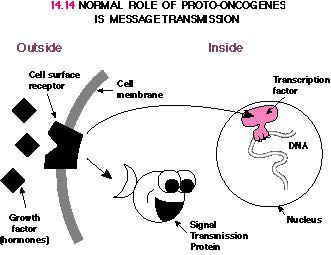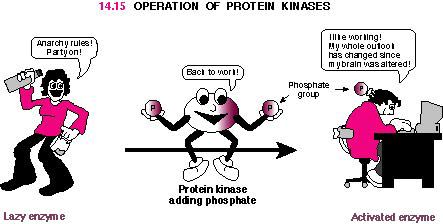|
| |
Molecular Biology
made simple and fun
Sample Page from Chapter 14
Cancer and Aging
Normal Role of Proto-Oncogenes
The pathway for activating cell growth and division has several stages. The
proto-oncogenes encode the proteins taking part in this scheme (Fig. 14.14).
Not surprisingly, mutations that result in hyperactivation of any of the components
involved in this can turn proto-oncogenes into oncogenes.

The major components involved are:
- Growth Factors: These are proteins circulating in the blood and bringing
messages from outside to the cell surface.
-
Cell Surface Receptors: These proteins are found in the cell membrane where
they receive messages from outside and pass the signal on.
- Transcription Factors: These proteins bind to and switch on genes in the
cell nucleus (see Ch. 11). This results in the synthesis of new proteins,
as opposed to the activation of those which are already present (Fig. 14.14).
- Signal transmission proteins: These pass on the signal from outside the
cell to enzymes or genes needed in cell division. Protein kinases are signal
transmission proteins that act by adding a phosphate group to enzymes that
are part of the machinery for growth and division. Some of these enzymes are
already hanging around, but in an inactive form. Addition of the phosphate
group switches needed enzymes on, and also turns others that are no longer
required, off (Fig. 14.15).

Return toMolecular
Biology made simple and fun
View sample page: nucleotide composition

Our
Commitment to You
At Quick Publishing we are committed to providing quality
educational, inspirational, and entertaining materials that
will help the reader to achieve educational or personal goals.
To learn more about our company, click here.
| |

